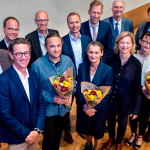When, as a PhD student in a hospital, you do not have a clinical background, the meeting with the patient can be motivating and also give research a new meaning. ‘Now I talk to the patients and feel how much their allergies affect them. I have been very moved by that’, says Michael who is a PhD student in a CAG fellowship under CAG Allergy in GCHSP.
With a background in molecular biology and the basic research environment, Michael wanted to try his hand at clinical research and get a little closer to the patients. In his PhD project, he looks at why some people still become allergic to nickel.
What is Special About Being a PhD in a CAG?
‘The special thing is the connection between the clinical and the subclinical. Everyone that I sit together with and who do clinical research, they are physicians. They do a lot of epidemiological research. With my background, I look at what happens at the cellular level. But you have to be able to translate it so it is not just about cells. What interests me is to bridge the gap between basic research and clinical research.
It is very rewarding that I can go over to the clinic and talk to patients. It means a lot to me, and I would not have the same opportunity if I only spent time at the university. When I talk to patients, I see how much it affects them. I have been very moved by that. To me, it is meaningful and worth a lot more than spreadsheets and lab analyses. After all, I cannot talk to mice’, says Michael.
What Does This Mean for Your Opportunities Going Forward?
‘With my background, I will most likely continue my studies and become an immunologist, and that is basic research. But I will have a lot of clinical experience, and not many immunologists have that. In addition, I have gained a larger and wider network. Through my university affiliation, I attend conferences with the University’s Department of Immunology and Microbiology and at the same time I have the clinical aspect when my primary supervisor from the hospital sends me to conferences with all the physicians.
I could easily see myself sitting at a university doing research in the future, but I also want to pull the research in the clinical direction’, says Michael.
Do You Experience Any Difference in the Approach to Research from Clinicians and Basic Scientists?
‘The language that we use has different concepts. I experience this e.g. when the physicians ask other questions than I do.
Physicians also conduct research in a different way than where I come from and have different knowledge. This is a challenge, but at the same time I am learning more. I get the opportunity to ask why people choose one treatment over another in practice, and in turn, I can tell them what a calcineurin inhibitor actually does. Physicians understand how to use calcineurin inhibitors in the treatment, but most often not the underlying molecular mechanisms.
It is a great advantage to sit in a place where you can ask about everything you do not know yourself. I myself bring the basic mindset and way of talking into the clinic. Overall, we learn more from each other when we work closer together, amongst others because there are many conversations you only have when you go to lunch together’.
Does Translational Learning Have any Bearing on the Dissemination of Your Research?
‘Immunologists often write to immunologists, but I think I am going to describe the research in somewhat broader terms so it becomes more accessible and not just to the research community. It can e.g. be for people who work with skin issues, but who are not associated with the field of allergies. Maybe these people do not find it exciting to read about the different proteins that react down in the immune system.
With my educational background, it is easy to wear blinkers. What I mean is that you forget the first question that was asked – the question that started out with a human being. When you mix the basic and the clinical, you achieve a more comprehensive understanding’, he explains.
What Does It Mean for Your Research That You Have Come Closer to the Patients?
On a daily basis, Michael works at the Allergy Research Centre, where it is part of his job to give advice regarding nickel allergy. Here, he has experienced the many contexts where nickel allergy plays a role in people’s everyday lives.
‘I have met someone who sold gloves and was afraid that they contained nickel. Another person was a musician and asked if you could get instruments without nickel because as someone having nickel allergy, he could no longer play his trumpet. Roughly speaking, I previously thought that nickel allergy was something women claimed they had in order to get expensive jewellery’. With this ironical remark, Michael cements his point about the learning potential that is inherent in translational research and the meeting between researcher and patient.
About Michael
Michael Wennervaldt Jørgensen er MSc in molecular biology and medical biology. He works at Gentofte Hospital at Videncenter for Allergi, where he is doing his son Ph.D. about nickel and allergy.
About CAG Allergy
The purpose of CAG Allergy is to reduce the increasing number of patients suffering from allergic diseases including eczema, asthma, and rhinitis as well as food and drug allergy.
The CAG chairmanship consist of: Jeanne Duus Johansen og Charlotte Menné Bonefeld.








